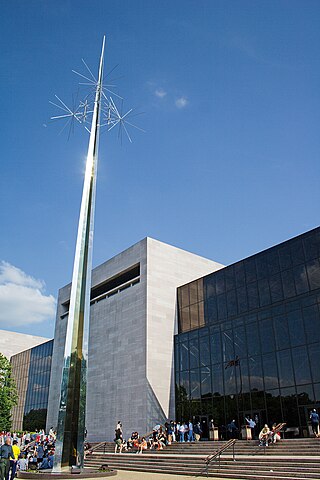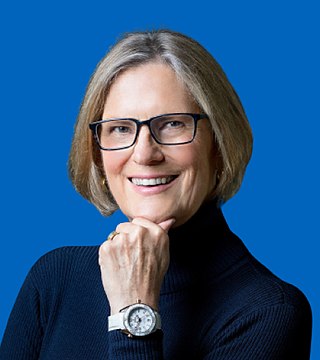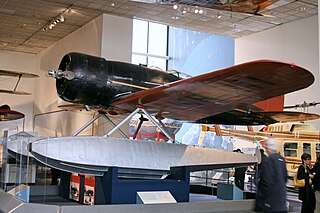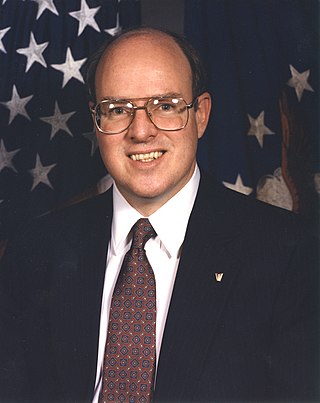Related Research Articles

The Smithsonian Institution, or simply the Smithsonian, is a group of museums, education and research centers, the largest such complex in the world, created by the U.S. government "for the increase and diffusion of knowledge." Founded on August 10, 1846, it operates as a trust instrumentality and is not formally a part of any of the three branches of the federal government. The institution is named after its founding donor, British scientist James Smithson. It was originally organized as the United States National Museum, but that name ceased to exist administratively in 1967.
Ronald Edward George Davies was an English writer who was a specialist in airline and air transport history, and commercial aviation economic research.

The National Air and Space Museum (NASM) of the Smithsonian Institution, is a museum in Washington, D.C., in the United States, dedicated to human flight and space exploration.

The Spirit of St. Louis is the custom-built, single-engine, single-seat, high-wing monoplane that Charles Lindbergh flew on May 20–21, 1927, on the first solo nonstop transatlantic flight from Long Island, New York, to Paris, France, for which Lindbergh won the $25,000 Orteig Prize.

Elbert Leander "Burt" Rutan is a retired American aerospace engineer and entrepreneur noted for his originality in designing light, strong, unusual-looking, and energy-efficient air and space craft. He designed the record-breaking Voyager, which in 1986 was the first plane to fly around the world without stopping or refueling. He also designed the Virgin Atlantic GlobalFlyer, which in 2006 set the world record for the fastest and longest nonstop non-refueled circumnavigation flight in history. In 2004, Rutan's sub-orbital spaceplane design SpaceShipOne became the first privately funded spacecraft to enter the realm of space, winning the Ansari X-Prize that year for achieving the feat twice within a two-week period.

Kathryn Dwyer Sullivan is an American geologist, oceanographer, and former NASA astronaut and US Navy officer. She was a crew member on three Space Shuttle missions.

The Steven F. Udvar-Hazy Center, also called the Udvar-Hazy Center, is the Smithsonian National Air and Space Museum (NASM)'s annex at Dulles International Airport in the Chantilly area of Fairfax County, Virginia. It holds numerous exhibits, including the Space Shuttle Discovery, the Enola Gay, and the Boeing 367-80, the main prototype for the popular Boeing 707 airliner.

The Lockheed Model 8 Sirius is a single-engined, propeller-driven monoplane designed and built by Jack Northrop and Gerard Vultee while they were engineers at Lockheed in 1929, at the request of Charles Lindbergh. Two versions of the same basic design were built for the United States Air Force, one made largely of wood with a fixed landing gear, and one with a metal skin and retractable landing gear, designated Y1C-25 and Y1C-23, respectively. Its basic role was intended to be as a utility transport.
Howard E. McCurdy is professor of public affairs in the public administration and policy department at American University.

Richard P. Hallion is Senior Adviser for Air and Space Issues, Directorate for Security, Counterintelligence and Special Programs Oversight, the Pentagon, Washington, D.C. He is responsible for analysis and insight regarding the conceptualization, evolution and utilization of sensitive national technological programs and related subject areas.

Dale Dehaven Myers was an American aerospace engineer who was Deputy Administrator of NASA, serving between October 6, 1986, and May 13, 1989. He was born in Kansas City, Missouri, and graduated with a Bachelor of Science degree in aeronautical engineering from the University of Washington in Seattle in 1943.

Alfred Victor Verville was an American aviation pioneer and aircraft designer who contributed to civilian and military aviation. During his forty-seven years in the aviation industry, he was responsible for the design and development of nearly twenty commercial and military airplanes. Verville is known for designing flying boats, military racing airplanes, and a series of commercial cabin airplanes. His planes were awarded with the Pulitzer Speed Classic Trophy in 1920 and 1924.

Paul E. Ceruzzi is curator emeritus at the Smithsonian's National Air and Space Museum in Washington, D.C.
Charles Harvard Gibbs-Smith was a British polymath historian of aeronautics and aviation. His obituary in The Times described him as "the recognised authority on the early development of flying in Europe and America" Richard P. Hallion called him "The greatest of all historians of early aviation".
The A. Verville Fellowship is an American senior scholarship established in the name of aviation pioneer Alfred V. Verville at the Smithsonian Institution's National Air and Space Museum. The Verville Fellowship is a competitive nine- to twelve-month in-residence fellowship for researching the history of aviation. The fellowship includes a $50,000 stipend with limited additional funds for travel and miscellaneous expenses.
Robert W. Smith is a scholar of history and the classics at the University of Alberta, and he directed the Science, Technology and Society Program in the Faculty of Arts. He researches the history of big science, especially U.S. technology and the history of spaceflight. He wrote The Space Telescope: A Study of NASA, Science, Technology and Politics and he co-edited Reconsidering Sputnik: Forty Years After the Soviet Satellite. He served as the Walter Hines Page Fellow at the National Humanities Center in North Carolina in 1993–94. He held the Charles A. Lindbergh Chair in Aerospace History at the U.S. National Air and Space Museum, Smithsonian Institution during the academic year 2006–07. He is interested in the technology and politics of the James Webb Space Telescope. In 2020 he was awarded the LeRoy E. Doggett Prize for his histories of the Hubble Space Telescope and the planned James Webb Space Telescope.
John William Fozard was a British aeronautical engineer who helped to design the Hawker Siddeley Harrier.
Tom Day Crouch is an American aeronautics historian and curator.

Roger D. Launius is an American historian and author of Lithuanian descent, a former chief historian of NASA. He retired in 2016 as Associate Director for Collections and Curatorial Affairs for the Smithsonian National Air and Space Museum in Washington, D.C. Launius is a consulting historian in air and space history. He has written many books on space flight, and also published on the history of the Latter Day Saint movement.

Frank H. Winter is an American historian and writer. He is the retired Curator of Rocketry of the National Air and Space Museum (NASM) of the Smithsonian Institution of Washington, D.C. Winter is also an internationally recognized historian of rocketry and spaceflight and the author of several landmark books besides numerous articles and papers on these topics.
References
- ↑ "Charles A. Lindbergh Chair in Aerospace History". Get Involved: Internships & Fellowships. National Air and Space Museum. Archived from the original on June 6, 2011. Retrieved May 26, 2011.
- 1 2 "National Air and Space Museum Research Fellowships". Get Involved: Internships & Fellowships. National Air and Space Museum. Archived from the original on April 10, 2011. Retrieved May 26, 2011.
- ↑ "National Air and Space Museum Press Kit: The Smithsonian and Flight". Press Room. National Air and Space Museum. Archived from the original on March 6, 2012. Retrieved May 26, 2011.
- 1 2 "Charles Harvard Gibbs-Smith", Staff Obituaries, Victoria and Albert Museum, archived from the original on January 15, 2011, retrieved May 26, 2011,
Reproduced with kind permission of The Times ©Times Newspapers Limited
- 1 2 3 "General Instructions for Guggenheim, Verville, and Lindbergh Fellowship Applicants" (PDF). Get Involved: Internships & Fellowships. National Air and Space Museum. Archived from the original (PDF) on July 26, 2011. Retrieved May 26, 2011.
- ↑ Kelsey, Benjamin S. (1982). The Dragon's Teeth?: The Creation of United States Air Power for World War II. Smithsonian Institution Press. p. 7. ISBN 0-87474-574-8.
- ↑ "R. E. G. (Ron) Davies Air Transport Collection 1910s-1980s". Collections. Smithsonian Institution. Retrieved May 26, 2011.
- ↑ Anderson, John David (2002). The airplane, a history of its technology. AIAA. p. 289. ISBN 1-56347-525-1.
- ↑ "John D. Anderson, Jr., PhD". Soaring 100. First Flight Foundation. Retrieved May 26, 2011.
- ↑ "Professor John Fozard, O.B.E." Daily Telegraph. London: Fozard.info. Archived from the original on August 16, 2011. Retrieved May 26, 2011.
- ↑ "Speakers and honorary degree recipient bios: Roger E. Bilstein, Ph.D." Commencement 2009. Doane College. Archived from the original on July 6, 2011. Retrieved May 26, 2011.
- 1 2 McCoy, Janet L. (October 7, 1999). "AU Professor Named Lindbergh Scholar at Air & Space Museum". News. Auburn University. Retrieved May 26, 2011.
- ↑ "William M. Leary". Obituary. Obits For Life. Retrieved May 26, 2011.
- ↑ "Dr. Williamson Murray". About Us: Charter: People. US Commission on National Security . Retrieved May 26, 2011.
- ↑ "Howard E. McCurdy" (PDF). CV. American University. Retrieved May 26, 2011.
- ↑ "Bettyann Holtzmann Kevles". History Faculty. Yale University. Archived from the original on November 4, 2011. Retrieved May 26, 2011.
- ↑ "Curriculum Vitae". Roger Launius's Blog. Roger Launius. Archived from the original on August 17, 2011. Retrieved May 26, 2011.
- ↑ "Kudos". TCU magazine. Texas Christian University. Winter 2002. Retrieved May 26, 2011.
- ↑ "Philip Scranton". History Department Faculty. Rutgers University. Archived from the original on August 17, 2011. Retrieved May 26, 2011.
- ↑ "John Krige". Science & Society. Emory University. Retrieved May 26, 2011.
- ↑ "James Rodger Fleming" (PDF). CV. Colby College. Retrieved May 26, 2011.
- ↑ "Smith, Robert". Fellows. Alberta Institute for American Studies. Archived from the original on July 6, 2011. Retrieved May 26, 2011.
- ↑ Kaufman, Marc (February 10, 2008). "NASA trying to bring magic to Mars mission". Washington Post. SF Gate. Retrieved May 26, 2011.
- ↑ "John M. Logsdon: Charles A. Lindbergh Chair Aerospace History". Biography. NASA . Retrieved May 26, 2011.
- ↑ "Prof Roy Macleod". Biography. University of Sussex . Retrieved May 26, 2011.
- ↑ "Hugh Slotten". Department of Media, Film and Communication. University of Otago . Retrieved May 26, 2011.
- ↑ "McCray named Charles A. Lindbergh Chair in Aerospace History at Smithsonian Air and Space Museum". Department of History. University of California Santa Barbara. Archived from the original on September 24, 2015. Retrieved August 18, 2015.
- ↑ "Former Astronaut and NOAA Administrator Kathy D. Sullivan Named National Air and Space Museum's Lindbergh Fellow". Smithsonian Institution. January 26, 2017. Retrieved December 5, 2019.
- ↑ "Prof. Alexander Geppert awarded Charles A. Lindbergh Chair in Aerospace History". Center for European and Mediterranean Studies, New York University. Retrieved March 23, 2018.
- ↑ "Dr Mick Broderick". www.rmit.edu.au. Retrieved December 16, 2021.